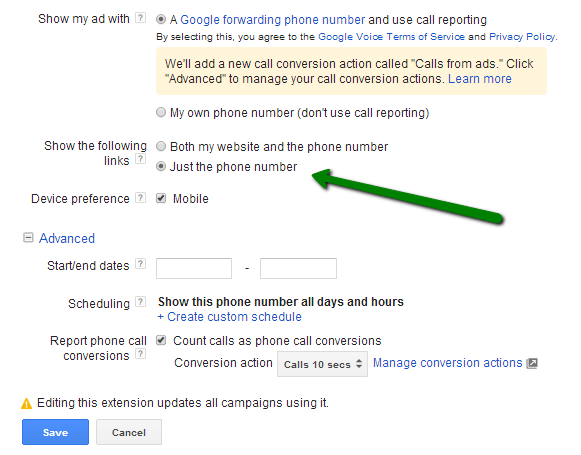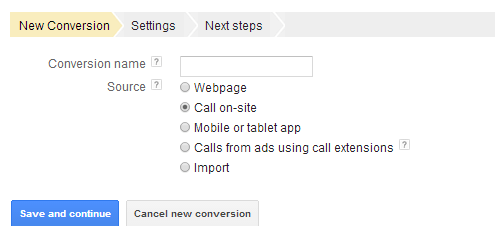Mobile Calls Are The New Conversions: 7 Tips For SEMs
Are you seeing depressing plateaus, or even declines, in your year-over-year conversion numbers? The fact is that a huge portion of search activity is moving to mobile. Soon, mobile activity will account for over 50% of searches. The problem is that the mobile conversions don’t follow the mobile searches. For many SEM accounts, this means […]
Are you seeing depressing plateaus, or even declines, in your year-over-year conversion numbers?
The fact is that a huge portion of search activity is moving to mobile. Soon, mobile activity will account for over 50% of searches. The problem is that the mobile conversions don’t follow the mobile searches.
For many SEM accounts, this means that year-over-year conversion volumes may be stagnating, or even look like they are declining. They probably aren’t; it’s just less trackable as people jump devices in their journey. People grab the device at hand and execute conversions in non-linear ways.
They are diverting our carefully tested funnels. This creates a mobile problem for SEM programs. Users click, they accrue cost. We all know there is some value — recognition, top-funnel and cross device things happening. But, our industry is obsessed with trackable ROI.
So what do we do about the issue? Larry Kim buried a nugget of gold in his post on Unicorn Ads with Great CTRs. He says:
When you’re testing mobile ads, you need to base your findings on call rate, not CTR or conversion rates.
Did you catch that? The way to use mobile paid search is to send phone calls. I wholeheartedly agree. I asked Larry to go into more depth on what he’s seeing at WordStream. He says:
The typical conversion rate of a click to a desktop landing page is around 4%. It’s brutal. Calls from click-to-call extension ads provide a way to short-circuit that leaky bucket entirely by having people call directly from the search engine results page without ever even having to go to your landing page! Wow. It’s not often that you can completely eliminate a stage in the conversion funnel like this. Our internal research shows that calls from ads are worth on average a whopping 3x more than clicks to your web page, yet cost around 20-30% less than desktop clicks on average!
So the goal should be to get the phone to ring as much as possible, because they’re the hottest leads you’ll ever get. The people who want to buy now will be the ones that call you. It’s like the call extensions are sucking the commercial intent out of the search engine results page. I had one client even extend their call center hours to take more orders by phone. So far, the vast majority of advertisers don’t seem to recognize this yet, but I suspect that it won’t be long before more catch on.
So, are you sold on calls yet? The only barrier to entry is that the world of phone calls is pretty new territory to most paid search professionals. So, let’s break down the barriers and get those phones ringing.
1. Get Over The Mental Hurdle
Call-based conversion optimization is very much like landing page and funnel optimization, only a bit more scary to the SEM because it’s real people talking in the real world. Don’t panic — there is still rich data to drive your decisions.
2. Prepare To Interface With A New Team
When you implement a serious call strategy for your mobile campaigns, you are going to be sending calls to some sort of sales team. This could mean agents in insurance, admissions counselors in education, or customer service for e-commerce — but essentially, sales.
The sales department is usually far removed from the marketing department. (Odd, isn’t it?) You probably are going to need to reach out to a new team to get your phone numbers and any internal data on the quality and outcome of the calls. What you are proposing is sending highly qualified inbound calls.
You are looking for the person that handles that. If it’s an organization that does lots of TV, direct mail or radio advertising, they probably have everything you need already in place. Did you know those guys were A/B testing creative 20 years ago via phone number tracking?
3. Get Versed In The IVR
To properly route and qualify the quality of your calls, you will probably be using an IVR — that is, an “Interactive Voice Response” system. You will recognize this as “Press 1 for AdWords, Press 2 for Analytics…”
Aside from routing and verifying quality, an IVR creates a barrier to entry that saves the costs of phone staff-time for users who don’t know what they want or don’t have the patience to qualify themselves.
Think of the IVR as your landing page — and, like landing pages, know that IVRs themselves, can be optimized.
4. Get Used To Some New Conversion Metrics
In AdWords, by using Google forwarding numbers, you can track phone calls as conversions based on their duration. Think of this duration as your “thank you page.”
The time it takes to get past the IVR (if you have one) is a good duration to start with. The right length will vary by business, but it’s worth putting some thought and analysis to it, because if you change the “right” duration for a conversion, you will break the historical continuity of your data.
Some companies will have rich call reporting systems that track call outcomes in more depth. Be prepared to analyze this data and be the person that makes sure it gets tied back to the source properly — ideally, down to the keyword level.
5. Rethink Your Campaigns
If you are serious about sending calls, the right call-to-action might be “call now” for your mobile-preferred ads. (It goes without saying that you’ll be implementing mobile-preferred ads.) If you are all-in to this call thing, you may want to set your call extension to “force” calls (phone only) and divert a landing page entirely.
If you give users a click or call choice in your ads, you can also track on-page calls on mobile now in AdWords and tie that back to your keywords via on-click tracking and a dynamically generated phone number on your page.
Call details reporting (on the dimensions tab) which shows the duration, area code and other valuable individual call data, only goes to the ad group level. If you need details at a keyword level for your most important keywords, consider single-keyword ad groups for them.
In any case, prepare to put some deep thought into your campaign and ad structure to maximize the success of your mobile call strategy.
6. Get Ready For Some New Data Patterns
When analyzing call data, we are adding a second human (who answered the phone) to our analysis. This means there are some new, different data patterns to look out for.
First, look for missed calls during business hours. Are they happening around lunch? Do the numbers look bad on Friday afternoons? The call team may be tired and ready for the weekend. Terrible week you can’t figure out – a bunch of new hires at the call center? Is the best sales person on vacation that week?
In any case, just remember that with a new set of people in the equation, better or poor performance does not always quantifiably tie with the time-of-day, day of week or any other factors you are analyzing. Don’t assume the leads are poorer quality without first examining the call center itself.
In fact, if you see anything odd in your data, start by calling the numbers – call them a lot. Make sure the calls actually connect and that somebody answers them. I’ve had several clients where they say they aren’t getting quality calls, but it turns out the line is dead air, an answering machine picks up at 2 p.m., or a jaded employee answers with a threatening “what!?”
7. Optimize & Schedule
First, scheduling is your friend. An answering machine message is a way less-qualified lead than a sales person answering the phone. In the absence of data, you probably don’t want to drive phone calls when there is nobody to answer them. You may want to go dark altogether on your campaigns, or perhaps just schedule the call extension to run when the phones are open.
I do suggest actually analyzing this for your business if you have the money and resources, but if not, err on the side of going dark when the answering machine picks up.
Get The Edge On Your Competition
It’s time to get that mobile search activity back in your conversion-data-filled arms and a mobile call strategy is the way to do it. It does take getting used to some new practices, but SEM doesn’t happen in a vacuum. You probably already mastered navigating LPO (landing page optimization) and CRO (conversion rate optimization), so jump over those hurdles and master phone calls to get the edge on your competition.
Opinions expressed in this article are those of the guest author and not necessarily Search Engine Land. Staff authors are listed here.
Related stories


